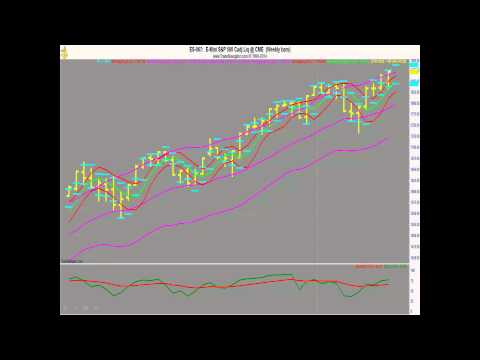.jpg)
Follow
Us:    
|
Don't Miss This Event!
Join us for a FREE educational webinar with professional trader Chris Verhaegh on February 21st at 3:30pm CT.
Chris will discuss his strategies to help you achieve the highest potential profits from earnings releases.
How to Trade Earnings Releases
Don't miss this great educational opportunity!
As a special bonus all attendees will receive a FREE giveaway courtesy of Chris.
Register for this free
webinar TODAY
Space is Limted!

|

During my first decade as a trader and analyst, I was introduced to a strategy that had an extremely high probability of profit. I wanted to understand the mathematical reason for the extraordinary success. It was then that a friend of mine uttered the words that changed my life and ushered in a period of groundbreaking research. My friend Pete said, "It has something to do with that bell curve thing." From that point forward, I have used my mathematical skills to discover unique and profitable trading systems.
It's been more than 20 years since I first entered the financial services business as a broker. I still remember my first speculative trade; it was a futures spread trade involving Live Hogs (all of my friends in the business were farmers). Soon after entering the finance business, I moved away from the brokerage side to the analysis side where I really wanted to be. I must have been doing something right, because I promoted to Director of Research at the nation's largest options-only research boutique. In 1993, I left that firm to start my own company to focus strictly on volatility.
|
|

Better
Business Bureau
 |
|
Click on authors name
to learn more
|
| |
|
|
After a 10,735-point run higher on the Dow Jones Industrials in just over a year, the index plunged more than 1,500 points in two days in early February 2018. Granted, there are fears that the Federal Reserve, now under Chairman Jerome Powell, could accelerate interest rate hikes and potentially slow our red-hot economy. The only reason we didn't see this threat under former Fed boss, Janet Yellen was because inflation didn’t post a significant threat.
We’ve seen worse crises and fears, though. Markets are resilient. So what’s the best thing to do after a drop of this size?
Lee Gettess provides our next bit of insight with a video covering his market expectations for the next week.
Then Inside Trading brings us a special bulletin from Don Fishback.
Last, Andy Chambers covers his Weekly Market Line in the Sand Newsletter.
Enjoy!
Adrienne LaVigne
TradeWins Publishing
 |
|
How to Trade the Excessive Panic
by
TradeWins Publishing
Ouch…
After a 10,735-point run higher on the Dow Jones Industrials in just over a year, the index plunged more than 1,500 points in two days in early February 2018.
It also wiped out $1 trillion of value with it.
Granted, there are fears that the Federal Reserve, now under Chairman Jerome Powell, could accelerate interest rate hikes and potentially slow our red-hot economy. The only reason we didn't see this threat under former Fed boss, Janet Yellen was because inflation didn’t post a significant threat.
In fact, inflation stayed under the 2% annual target rate for quite some time.
However, with a tighter job market, higher wage growth and the idea that tax cuts could accelerate growth, there were concerns of higher inflation at the time, which could lead to higher interest rates. If, for example, inflation soared above 2% – which was the chief concern – the Fed would be forced to quickly accelerate hikes to tighten credit and stop inflation threats.
Trade the Excessive Panic
|
Lee
Gettess' Market Sense
by Lee Gettess
Lee
Gettess is a top trader who is excited
to bring you his video newsletter.
Each week, Lee will share his predictions
on what he anticipates from the bond
and S&P markets.
Watch
Video
|
Special Bulletin
by
Don Fishback
The following is a special announcement from Don Fishback’s ODDS
XIV reopened, the stock market soared, but most importantly, VVIX remains extremely high at 161+.
That’s what happened last week. But I want to turn back the clock to Monday to examine and explain a bit about what happened when a normal down day turned into a nightmare. Because there are a lot of conspiracy theories out there.
I am going to present you with the facts that I have been able to gather. Then I am going to speculate as to what happened. I don’t know for sure, just like no one else knows. And we won’t know unless and until there are some sorts of proceedings that set out to obtain the facts.
But after more than three decades of doing this each and every day, I think my explanation makes the most sense.
Special Bulletin
|
Weekly Market Line in the Sand
by Andy Chambers
Every week Andy publishes his Weekly Market Line in the Sand Newsletter. The following are trade updates from his most recent issue.
The long term trend is up. However the momentum has shifted to the bears. The market is overdue for a correction. It looks like that might have started late last month. Sell rallies! There’s a new order for EWZ. There are new fills for IWM, OIH, and COP. We are going to leave the DIA, SPY, QQQ, and XHB orders in place. Maybe we’ll get filled on a rally.
S&P E-Mini Futures Weekly: The long-term trend is up. A close over 2878.50 could result in a further advance. The bears have been in charge recently. We expect the overall trend to be down for a while. The initial hurdle for the bears is seen at 2416.75.
DIA Weekly: The long-term trend is up. A close over 265.93 could result in a further advance. The bears have been in charge recently. We expect the overall trend to be down for a while. The initial hurdle for the bears is seen at 215.73.
To Learn More Click Here
|
|

.jpg)




